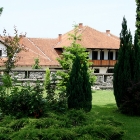Zica Monastery, 13th century Byzantine – Romanesque monastery in Serbia
The birth of Serbia is tied to a royal family with religious inclinations, therefore some monasteries in the country are crucial not only from spiritual, but also from historic standpoint. The founder of Serbian dynasty was Stefan Nemanja, a warrior and ruler who abdicated to become a monk together with his wife (in different convents). Nemanja founded Studenica Monastery in the 12 century and used it for a while.
The second generation of his dynasty chose as a central religious point Zica Monastery, built in the beginning of the next century and found not far away. Two of the sons of Stefan Nemanja became of great importance for Serbia and used this place. The one who would later be known as St Sava became the first archbishop of Serbia and a patron saint of the country. It was him who crowned his brother, Stefan Nemanic (Stefan II) as the first king of Serbia right in the church of Zica, which he had founded. Starting then, all kings of Serbia had to be crowned at Zica to be recognized as legitimate.
Like Studenica, the church of Zica is rather of modest dimensions, far from what one would expect from a royal cathedral. However, it is very balanced and harmonious, tributary to the Greek architectural style. Like most Orthodox traditional churches it is a perpetuation of Byzantine art – the frescoes and mosaics of Zica especially preserve this teaching.
Byzantine religious architecture evolved in the West into Romanesque architecture, an attempt by the former barbarian tribes to recover the glory of Rome and its basilicas by copying what in the East Roman Empire had continuity. This style is recognizable by the rounded arches, the thick stone or brick walls, the absence of external decorations, the roundness of the eastern end of the church (where the altar is found). While the West turned to this style as a revival of what was once a glorious past, for the East this was rather a question of conservation. In Greece and neighboring countries this Byzantine architecture refined on Mount Athos is very common. The architects and painters for Zica were Greeks, but they gave it a local tone, using the Romanesque already employed in Dubrovnik and for the monasteries in Kotor Bay. The Serbs call this fusion of Romanesque vaults with Byzantine dome Raska style, from a nearby river. Both the original 13 century church at Zica, destroyed in raids and fires, and the present one, rebuild a century later, were red on the outside, to symbolize the blood of the martyrs. Today, the tone has changed to a pleasant crimson shade.
Mai multe despre: Religious architecture, Serbia • Byzantine • Christian • fresco • Krusevica • monastery • Orthodox painting • Raska • Serbia • St Sava • Stefan Nemanic • Yugoslavia • Zica Monastery- Home Page
start page - Architecture
landmark buildings - Sacred architecture
places of worship - Nature
landscape photography - Concert
performing artists - Christmas
Santa Claus pictures
- Jooble
jobs for photographers - Escape
an out of control blog - Merry Christmas
The best organizer of Christmas parties - Astro photo
Eclipse hunting and astrological photography


















